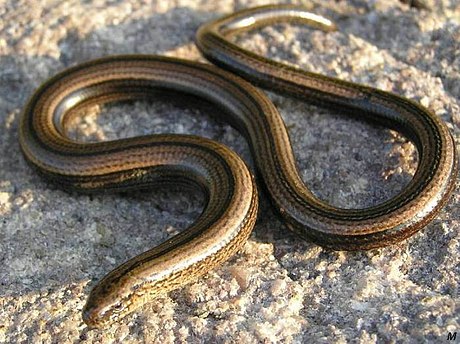Anguis fragilis (the slow-worm, or blindworm) is a lizard which is limbless (meaning it has no legs or arms).[1] It has a wide distribution in Europe and Asia, and is one of the few reptiles native to Britain.
| Anguis fragilis | |
|---|---|
 | |
| Scientific classification | |
| Kingdom: | |
| Subphylum: | |
| Class: | |
| Order: | |
| Family: | |
| Genus: | |
| Binomial name | |
| Anguis fragilis Linnaeus, 1758 | |

When a slow-worm is in danger it can shed (break off) its tail and escape. It can then grow back a new, shorter tail, which it cannot shed.
The female often has a stripe along the back and the male may have blue spots.
Instead of laying eggs, the females give birth to live young (viviparous birth). In the days leading up to birth the female can often be seen basking in the sun on a warm road.
Slow-worms are often called snakes, but they are not. Slow-worms can blink, but snakes cannot. They shed their skin in patches like other lizards, rather than the whole skin as most snakes do.
Adult slow-worms grow to be about 50 centimetres long. They are known for their very long life. One was said to have been fifty four years old.
There are not as many slow-worms as there used to be. Many places where they used to live have been built on. In gardens they can be killed by cats.
Wikiwand in your browser!
Seamless Wikipedia browsing. On steroids.
Every time you click a link to Wikipedia, Wiktionary or Wikiquote in your browser's search results, it will show the modern Wikiwand interface.
Wikiwand extension is a five stars, simple, with minimum permission required to keep your browsing private, safe and transparent.
